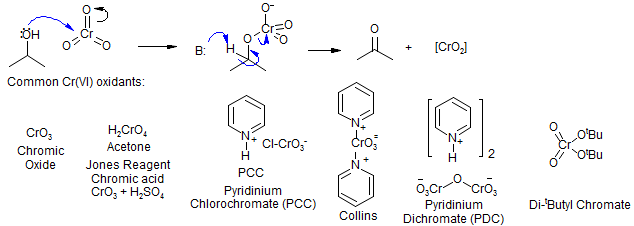Chromium Oxidants
A variety of chromium(VI) oxides derived from CrO3 were long among the most popular reagents for oxidation of alcohols to ketones and aldehydes. The properties of the reagent can be altered by Lewis base complexation. Pyridinium chlorochromate, pyridinium dichromate and chromic oxide-pyridine (Collins reagent) are the most commonly used ones. The oxidation of primary alcohols can usually be stopped at the aldehyde stage, although oxidation to carboxylic acids can also be achieved. 1,2-Glycols undergo C-C bond cleavage.
The Oxidation of Alcohols by Modified Oxochromium(VI)-Amine Reagents,
Luzzio, F. A. Org. React. 1998, 53, 1-221.

Solanapyrone: Hagiwara, H.; et al. J. Org. Chem. 2002, 67, 5969

Tertiary allylic alcohols are oxidized to rearranged enones:

Aromaticin: Majetich, G.; Song, J. S.; Leigh, A. J.; Condon, S. M. J. Org. Chem. 1993, 58, 1030. DOI

Allylic Oxidation
The functionalization of allylic positions can be done by several distinct methods (allylic halogenation, singlet oxygen, selenium dioxide). Chromium oxide reagents are one of the options to do this difficult transformation. In favorable cases, Cr(VI) complexes will oxidize alkenes to enones. There are regioselectivity issues, and the reaction seems to work best when one of the double bond termini is fully substituted (i.e. cannot be oxidized to a ketone).
Sterpurine: Harmata, M.; Bohnert, G. J. Org. Lett. 2003, 5, 59

Manzamine: Humphrey, J. M.; Liao, Y.; Ali, A.; Rein, T.; Wong, Y.-L.; Chen, H.-J.; Courtney, A. K.; Martin, S. F. J. Am. Chem. Soc. 2002, 124, 8584-92
